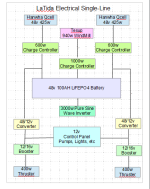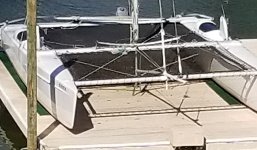HillCruiser
10 W
- Joined
- Jan 19, 2022
- Messages
- 81
This project is to build a sailing frame around a sea kayak and outfit for extended length expeditions.
The snapshot is from the 3D model that I use to plan and build; looking up from under the water, with a "glass" rendering so you can look inside everything

The boat is essentially complete now except for the electrical system.
I had installed a small 12v solar system but after tinkering with ebike upgrades I realized it was going to be inadequate.
So I bought a couple 48v 425w panels to mount on the cabin roof, a 48v Tesup Master940 wind generator and a 100ah 48v LiFePo4 battery. The 12v electrical is complete: 2 bilge pumps, 2 fresh water pumps, 1 seawater pump, nav lights, horn, searchlight, etc.
I also have mounted a pair of blue robotics 4" T200 thrusters that can run on 12-20v; which I want to run at 16v to get 400w of power from each. I really like the idea of a submerged motor to prevent overheating. The thrusters are mounted amidship about 12' apart.
Originally the thrusters were to get in/out of the harbor but now that I will have more power available, I'm trying to decide how to better utilize them; perhaps for the autopilot instead of a tiller/rudder?
The solar system will be the two 425w panels, a small MPPT for each and a 3000w pure sine wave inverter.
The wind generator is rated at 940w and comes with it's own controller.
The length is 22' and the sails are a total of 180 sq.ft. in a Bermuda configuration.
The estimated weight of the craft is 1500 lbs (to be verified in the spring).
Constant critical loads are the autopilot (Raspberry Pi with touchscreen linked to an Arduino), GPS, radio, emergency beacon that total about 20w, not including the actuator power.
I want to add electric drive capability but can't decide which way to go. I have a spare 48v 750w rear hub motor and controller that I could use. Or maybe I should purchase a couple 48v thrusters or...
Emphasis is on reliability and flexibility; Speed isn't important...
The snapshot is from the 3D model that I use to plan and build; looking up from under the water, with a "glass" rendering so you can look inside everything

The boat is essentially complete now except for the electrical system.
I had installed a small 12v solar system but after tinkering with ebike upgrades I realized it was going to be inadequate.
So I bought a couple 48v 425w panels to mount on the cabin roof, a 48v Tesup Master940 wind generator and a 100ah 48v LiFePo4 battery. The 12v electrical is complete: 2 bilge pumps, 2 fresh water pumps, 1 seawater pump, nav lights, horn, searchlight, etc.
I also have mounted a pair of blue robotics 4" T200 thrusters that can run on 12-20v; which I want to run at 16v to get 400w of power from each. I really like the idea of a submerged motor to prevent overheating. The thrusters are mounted amidship about 12' apart.
Originally the thrusters were to get in/out of the harbor but now that I will have more power available, I'm trying to decide how to better utilize them; perhaps for the autopilot instead of a tiller/rudder?
The solar system will be the two 425w panels, a small MPPT for each and a 3000w pure sine wave inverter.
The wind generator is rated at 940w and comes with it's own controller.
The length is 22' and the sails are a total of 180 sq.ft. in a Bermuda configuration.
The estimated weight of the craft is 1500 lbs (to be verified in the spring).
Constant critical loads are the autopilot (Raspberry Pi with touchscreen linked to an Arduino), GPS, radio, emergency beacon that total about 20w, not including the actuator power.
I want to add electric drive capability but can't decide which way to go. I have a spare 48v 750w rear hub motor and controller that I could use. Or maybe I should purchase a couple 48v thrusters or...
Emphasis is on reliability and flexibility; Speed isn't important...




